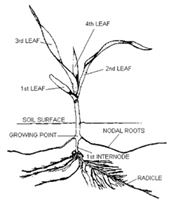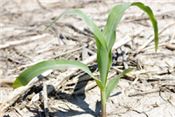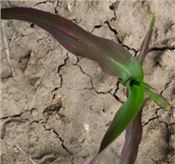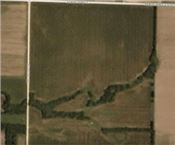|
Ugly Corn Is A Whole Lot Better Than No Corn In 2019!

GREGORY A. LUCE AND DR. PETER C. SCHARF
COLUMBIA, MO.
There are some quite pretty corn stands in Missouri this year but there are also some quite ugly ducklings. This is not really unique to this year and corn generally goes through a period of looking a bit ragged. As corn develops through the early stages of growth the seedling relies on reserves from the kernel initially. The nodal (permanent) root system starts at V1 and is very visible by the V2 stage.
At the V3 stage the nodal roots are developing to the point of taking over in supplying the plant with nourishment. As this process progresses, corn plants from V3 to V5, particularly when conditions are less than optimal, often look rather ugly. Such is the case in the 2019 growing season, with extended wet conditions and cold periods. So it is no wonder that some of the corn crop is pale, yellow, also might be a bit purple, and has some uneven growth. Although we would like the corn to be completely even and dark green, don't despair, the corn will be turning the corner soon.
Now that we are in late May and fast approaching June, warmer temperatures will continue to improve the appearance of the corn crop. As we reach the V5 stage and beyond the root system is typically growing rapidly and established enough to support healthy above ground growth.
Know the Growth Stage of Your Corn
To determine corn leaf stages, count the leaves that have fully emerged from the whorl with a collar visible. For example, the corn in the picture is at late V2, two-leaf stage. Notice that it actually has four visible leaves, and there is a fifth leaf in the whorl. However, only two collars are visible. There is generally two or three more leaves visible beyond those with collars.
It is important to note that the growing point remains below ground until about the V6 stage. Above ground leaf damage prior to that stage is of relatively small consequence. However, from V6 on, the impact from above ground injury becomes more significant.
Growth staging is important to understand the timing of developmental processes. It is also very critical for the proper application of some post-emergence herbicides. Always read and follow herbicide labels carefully.
Purple coloration is apparent somewhere in Missouri cornfields almost every year. It is often related to cool night temperatures, followed by bright sunny days. Corn normally outgrows the "purpling" condition by V6, or by the time it is about 12 inches tall. The purplish color is due to several factors, cool nights, early season stress and restricted root growth. Corn leaves produce sugars by photosynthesis and these sugars are metabolized to generate the plant's energy for shoot and root growth and development. When the growth slows down, the sugars tend to accumulate in the leaf. This triggers anthocyanin pigment formation that is expressed as purple color. Some corn hybrids express the purple more than others. This type of purple expression is not a big concern and doesn't have a lasting negative effect.
Purpling can also be due to other factors such as phosphorus deficiency, root injury from insects, fertilizer burn, compaction or herbicides. Genetic or hybrid purpling tends to be uniform across the field, whereas factors involving root injury or a phosphorus deficiency will follow an application pattern or soil type.
Is the Pale, Yellow Corn Nitrogen Related?
The wet spring with cool periods has been a recipe for pale corn. Nitrogen is nearly always the reason, but lack of oxygen in the root zone will cause nitrogen deficiency even when there is enough N in the soil.
As soil dries, oxygen returns, and growth rates pick up, plants will green up to normal coloring if enough N remains. But with most of the excess rain coming in May when soils were mostly above 60 degrees, the potential for denitrification loss of N is high, especially on poorly-drained soils (and we have a lot of those). This type of loss only affects nitrate-N, but all nitrogen fertilizer is eventually converted to nitrate in soil. The later the main N application, the lower the potential for loss since less fertilizer N has converted to nitrate. That is one blessing from the weather that prevented normal application times for nitrogen. Also, anhydrous converts to nitrate much slower than other fertilizers. If anhydrous and urea were applied on the same date in neighboring fields in mid-April, more N has been lost from the field that got the urea.
The good news is that corn can recover, more than we once thought, from a lack of nitrogen early in the season. But only if the lost N is replaced. The hard question is, “How can I figure out whether N loss is a big problem in a lot of fields quickly?” Soil nitrate/ammonium tests work but are slow, difficult to do well, and probably won't capture the spatial variability in N loss (which is usually patchy). We now have access to frequent satellite images for most fields and, once the corn is big enough to see its color, this is a quick and easy way to assess N status. You can get a free account on planet.com and get a birds-eye view of how your fields look. They usually get 3 to 5 images/week of most fields (but sometimes all you can see is clouds). If 5 percent of a field is yellow-green, it's not worth fixing, but if 50 percent is yellow-green, it will pay back in a big way to apply more N. You can get variable-rate prescriptions based on satellite images, so that you only invest in more N where N was lost, but MU Extension says that I'm not allowed to tell you how.
The root of the matter may very well be in the roots! So often we observe fields or individual plants without digging. There is an easy fix, be sure to keep a shovel with you when checking fields! Observe the whole field to determine if there is a pattern indicating an issue and dig up plants to check out the root growth and development. If root development is poor and plants are yellow, additional root growth may help the plant to access more nitrogen (or potassium or phosphorus which are also taken up more slowly when soil oxygen levels are low). ∆
GREGORY A. LUCE: Adjunct Instructor, Division of Plant Sciences, University of Missouri
DR. PETER SCHARF: Professor Plant Sciences, University of Missouri
 Late V2 corn plant.
Photo by Bill Wiebold
Late V2 corn plant.
Photo by Bill Wiebold
 Look for patterns to help determine cause of the purple corn.
Photo by Greg Luce
Look for patterns to help determine cause of the purple corn.
Photo by Greg Luce

May 30 satellite image of a corn field near Lamar, MO. The lighter plant color near
the trees (low areas of field) indicates N deficiency.
Image from Planet Labs
|
|